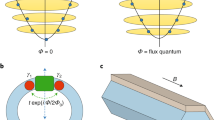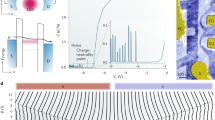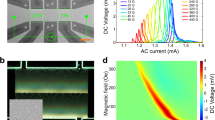Abstract
Advances in nanofabrication techniques have made it possible to make devices in which superconducting electrodes are connected to non-superconducting nanostructures such as quantum dots. The properties of these hybrid devices result from a combination of a macroscopic quantum phenomenon involving large numbers of electrons (superconductivity) and the ability to control single electrons, offered by quantum dots. Here we review research into electron transport and other fundamental processes that have been studied in these devices. We also describe potential applications, such as a transistor in which the direction of a supercurrent can be reversed by adding just one electron to a quantum dot.
This is a preview of subscription content, access via your institution
Access options
Subscribe to this journal
Receive 12 print issues and online access
$259.00 per year
only $21.58 per issue
Buy this article
- Purchase on Springer Link
- Instant access to full article PDF
Prices may be subject to local taxes which are calculated during checkout






Similar content being viewed by others
References
Tinkham, M. Introduction to Superconductivity (McGraw-Hill, 1996).
Kastner, M. A. Artificial atoms. Phys. Today 46, 24–31 (January 1993).
Kouwenhoven, L. P., Austing, D. G. & Tarucha, S. Few-electron quantum dots. Rep. Prog. Phys. 64, 701–736 (2001).
Josephson, B. D. Possible new effects in superconductive tunnelling. Phys. Lett. 1, 251–253 (1962).
Jaklevic, R. C. et al. Quantum interference effects in Josephson tunneling. Phys. Rev. Lett. 12, 159–160 (1964).
Clarke, J. & Wilhelm, F. K. Superconducting quantum bits. Nature 453, 1031–1042 (2008).
Likharev, K. K. Superconducting weak links. Rev. Mod. Phys. 51, 101–159 (1979).
van Dam, J. A., Nazarov, Y. V., Bakkers, E. P., De Franceschi, S. & Kouwenhoven, L. P. Supercurrent reversal in quantum dots. Nature 442, 667–670 (2006).
Katsaros, G. et al. Hybrid superconductor–semiconductor devices made from self-assembled SiGe nanocrystals on silicon. Nature Nanotech. 5, 458–464 (2010).
Winkelmann, C. B., Roch, N., Wernsdorfer, W., Bouchiat, V. & Balestro, F. Superconductivity in a single C60 transistor. Nature Phys. 5, 876–879 (2009).
Ralph, D. C., Black, C. T. & Tinkham, M. Spectroscopic measurements of discrete electronic states in single metal particles. Phys. Rev. Lett. 74, 3241–3244 (1995).
Kasumov, A. Y. et al. Supercurrents through single-walled carbon nanotubes. Science 284, 1508–1511 (1999).
Morpurgo, A. F., Kong, J., Marcus, C. M. & Dai, H. Gate-controlled superconducting proximity effect in carbon nanotubes. Science 286, 263–265 (1999).
Buitelaar, M. R., Nussbaumer, T. & Schönenberger, C. Quantum dot in the Kondo regime coupled to superconductors. Phys. Rev. Lett. 89, 256801 (2002).
Buitelaar, M. R. et al. Multiple Andreev reflections in a carbon nanotube quantum dot. Phys. Rev. Lett. 91, 057005 (2003).
Jarillo-Herrero, P., van Dam, J. A. & Kouwenhoven, L. P. Quantum supercurrent transistors in carbon nanotubes. Nature 439, 953–956 (2006).
Jorgensen, H. I., Grove-Rasmussen, K., Novotny, T., Flensberg, K. & Lindelof, P. E. Electron transport in single-wall carbon nanotube weak links in the Fabry-Perot regime. Phys. Rev. Lett. 96, 207003 (2006).
Cleuziou, J-P., Wernsdorfer, W., Bouchiat, V., Ondarcuhu, T. & Monthioux, M. Carbon nanotube superconducting quantum interference device. Nature Nanotech. 1, 53–59 (2006).
Cleuziou, J-P., Wernsdorfer, W., Bouchiat, V., Ondarcuhu, T. & Monthioux, M. Gate-tuned high frequency response of carbon nanotube josephson junctions. Phys. Rev. Lett. 99, 117001 (2007).
Ingerslev Jørgensen, H. et al. Critical current 0-π transition in designed Josephson quantum dot junctions. Nano Lett. 7, 2441–2445 (2007).
Eichler, A. et al. Even-odd effect in Andreev transport through a carbon nanotube quantum dot. Phys. Rev. Lett. 99, 126602–126605 (2007).
Pallecchi, E., Gaass, M., Ryndyk, D. A. & Strunk, C. Carbon nanotube Josephson junctions with Nb contacts. Appl. Phys. Lett. 93, 072501 (2008).
Eichler, A. et al. Tuning the Josephson current in carbon nanotubes with the Kondo effect. Phys. Rev. B 79, 161407 (2009).
Grove-Rasmussen, K. et al. Superconductivity-enhanced bias spectroscopy in carbon nanotube quantum dots. Phys. Rev. B 79, 134518 (2009).
Jorgensen, H. I., Grove-Rasmussen, K., Flensberg, K. & Lindelof, P. E. Critical and excess current through an open quantum dot: Temperature and magnetic-field dependence. Phys. Rev. B 79, 155441 (2009).
Wu, F. et al. Single-walled carbon nanotube weak links in Kondo regime with zero-field splitting. Phys. Rev. B 79, 073404 (2009).
Liu, G., Zhang, Y. & Lau, C. N. Gate-tunable dissipation and “superconductor-insulator” transition in carbon nanotube Josephson junctions. Phys. Rev. Lett. 102, 016803–016806 (2009).
Doh, Y. J. et al. Tunable supercurrent through semiconductor nanowires. Science 309, 272–275 (2005).
Xiang, J. et al. Ge/Si nanowire mesoscopic Josephson junctions. Nature Nanotech. 1, 208–213 (2006).
Sand-Jespersen, T. et al. Kondo-enhanced Andreev tunneling in InAs nanowire quantum dots. Phys. Rev. Lett. 99, 126603–126206 (2007).
Sand-Jespersen, T. et al. Tunable double dots and Kondo enhanced Andreev transport in InAs nanowires. J. Vac. Sci. Technol. B 26, 1609–1612 (2008).
Doh, Y. J. et al. Andreev reflection versus Coulomb blockade in hybrid semiconductor nanowire devices. Nano Lett. 8, 4098–4102 (2008).
Frielinghaus, R. et al. Josephson supercurrent in Nb/InN-nanowire/Nb junctions. Appl. Phys. Lett. 96, 132504–132506 (2010).
Buizert, C., Oiwa, A., Shibata, K., Hirakawa, K. & Tarucha, S. Kondo universal scaling for a quantum dot coupled to superconducting leads. Phys. Rev. Lett. 99, 136806 (2007).
Deacon, R. S. et al. Tunneling spectroscopy of Andreev energy levels in a quantum dot coupled to a superconductor. Phys. Rev. Lett. 104, 076805 (2010).
Kanai, Y. et al. Electrical control of Kondo effect and superconducting transport in a side-gated InAs quantum dot Josephson junction. Available at http://arxiv.org/abs/0912.3094 (2009).
Aslamazov, A. G. & Fistul, M. V. Resonant tunneling in superconductor-semiconductor-superconductor junctions. Sov. Phys. JETP 55, 681–684 (1982).
Beenakker, C. W. J. & van Houten, H. in Single-Electron Tunneling and Mesoscopic Devices (eds Koch, H. & Lübbig, H.) 175–179 (Springer, 1992); see also http://xxx.lanl.gov/abs/condmat/0111505 (2001).
Beenakker, C. W. J. & van Houten, H. Josephson current through a superconducting quantum point contact shorter than the coherence length. Phys. Rev. Lett. 66, 3056–3059 (1991).
Liang, W. J. et al. Fabry–Perot interference in a nanotube electron waveguide. Nature 411, 665–669 (2001).
Vion, D., Götz, M., Joyez, P., Esteve, D. & Devoret, M. H. Thermal activation above a dissipation barrier: switching of a small Josephson junction. Phys. Rev. Lett. 77, 3435–3438 (1996).
Averin, D. V. & Nazarov, Yu. V. in Single Charge Tunneling: Coulomb Blockade Phenomena in Nanostructures (eds Grabert, H. & Devoret, M. H.) 217–247 (Plenum and NATO Scientific Affairs Division, 1992).
Glazman, L. I. & Matveev, K. A. Resonant Josephson current through Kondo impurities in a tunnel barrier. JETP Lett. 49, 659–662 (1989).
Bulaevskii, L. N., Kuzii, V. V. & Sobyanin, A. A. Superconducting system with weak coupling to the current in the ground state. JETP Lett. 25, 290–294 (1977).
Tsuei, C. C. & Kirtley, J. R. Pairing symmetry in cuprate superconductors. Rev. Mod. Phys. 72, 969–1016 (2000).
Golubov, A. A., Kupriyanov, M. Yu & Il'ichev, E. The current-phase relation in Josephson junctions. Rev. Mod. Phys. 76, 411–469 (2004).
Ryazanov, V. V. et al. Coupling of two superconductors through a ferromagnet: evidence for a pi junction. Phys. Rev. Lett. 86, 2427–2430 (2001).
Kontos, T. et al. Josephson junction through a thin ferromagnetic layer: Negative coupling. Phys. Rev. Lett. 89, 137007 (2002).
Wollman, D. A. et al. Experimental determination of the superconducting pairing state in YBCO from the phase coherence of YBCO-Pb dc SQUIDs. Phys. Rev. Lett. 71, 2134–2137 (1993).
Baselmans, J. J. A. et al. Reversing the direction of the supercurrent in a controllable Josephson junction. Nature 397, 43–45 (1999).
Spivak, B. I. & Kivelson, S. A. Negative local superfluid densities: The difference between dirty superconductors and dirty Bose liquids. Phys. Rev. B 43, 3740–3743 (1991).
Kouwenhoven, L. & Glazman, L. Revival of the Kondo effect. Phys. World 14, 33–38 (January 2001).
van der Wiel, W. G. et al. The Kondo effect in the unitary limit. Science 289, 2105–2108 (2000).
Clerk, A. A. & Ambegaokar, V. Loss of π-junction behavior in an interacting impurity Josephson junction. Phys. Rev. B 61, 9109–9112 (2000).
Rozhkov, A. V., Arovas, D. P. & Guinea, F. Josephson coupling through a quantum dot. Phys. Rev. B 64, 233301 (2001).
Vecino, E., Martín-Rodero, A. & Levy Yeyati, A. Josephson current through a correlated quantum level: Andreev states and pi junction behavior. Phys. Rev. B 68, 035105 (2003).
Avishai, Y., Golub, A. & Zaikin, A. D. Superconductor-quantum dot-superconductor junction in the Kondo regime. Phys. Rev. B 67, 041301 (2003).
Choi, M. S., Lee, M., Kang, K. & Belzig, W. Kondo effect and Josephson current through a quantum dot between two superconductors. Phys. Rev. B 70, 020502 (2004).
Siano, F. & Egger, R. Josephson current through a nanoscale magnetic quantum dot. Phys. Rev. Lett. 93, 047002 (2004).
Oguri, A., Tanaka, Y. & Hewson, A. C. Quantum phase transition in a minimal model for the Kondo effect in a Josephson junction. J. Phys. Soc. Jpn 73, 2494–2504 (2004).
Sellier, G., Kopp, T., Kroha, J. & Barash, Y. S. π junction behavior and Andreev bound states in Kondo quantum dots with superconducting leads. Phys. Rev. B 72, 174502 (2005).
Karrasch, C., Oguri, A. & Meden V. Josephson current through a single Anderson impurity coupled to BCS leads. Phys. Rev. B 77, 024517 (2008).
Meng, T., Florens, S. & Simon, P. Self-consistent description of Andreev bound states in Josephson quantum dot devices. Phys. Rev. B 79, 224521 (2009).
Pillet, D-H. et al. Revealing the electronic structure of a carbon nanotube carrying a supercurrent. Available at http://arxiv.org/abs/1005.0443 (2010).
Dirks, T. et al. Andreev bound state spectroscopy in a graphene quantum dot. Available at http://arxiv.org/abs/1005.2749 (2010).
Bouchiat, V. Detection of magnetic moments using a nano-SQUID: limits of resolution and sensitivity in near-field SQUID magnetometry. Supercond. Sci. Technol. 22, 064002 (2009).
Etaki, S. et al. Motion detection of a micromechanical resonator embedded in a d.c. SQUID. Nature Phys. 4, 785–788 (2008).
Xue, F. et al. Controllable coupling between flux qubit and nanomechanical resonator by magnetic field. New J. Phys. 9, 35 (2007).
Sonne, G., Shekhter, R. I., Gorelik, L. Y., Kulinich, S. I. & Jonson, M. Superconducting pumping of nanomechanical vibrations. Phys. Rev. B 78, 144501 (2008).
Sonne, G., Peña-Aza, M. E., Gorelik, L. Y., Shekhter, R. I. & Jonson, M. Cooling of a suspended nanowire by an ac Josephson current flow. Phys. Rev. Lett. 104, 226802 (2010).
O'Connell, A. D. et al. Quantum ground state and single-phonon control of a mechanical resonator. Nature 464, 697–703 (2010).
Recher, P., Sukhorukov, E. V. & Loss, D. Andreev tunneling, Coulomb blockade, and resonant transport of nonlocal spin-entangled electrons. Phys. Rev. B 63, 165314 (2001).
Lesovik, G. B., Martin, T. & Blatter, G. Electronic entanglement in the vicinity of a superconductor. Eur. Phys. J. B 24, 287–290 (2001).
Bouchiat, V. et al. Single-walled carbon nanotube-superconductor entangler: noise correlations and Einstein–Podolsky–Rosen states. Nanotechnol. 14, 77–85 (2003).
Hofstetter, L., Csonka, S., Nygard, J. & Schönenberger, C. Cooper pair splitter realized in a two-quantum-dot Y-junction. Nature 461, 960–963 (2009).
Herrmann, L. G. et al. Carbon nanotubes as Cooper-pair beam splitters. Phys. Rev. Lett. 104, 026801 (2010).
Schoelkopf, R. J. & Girvin, S. M. Wiring up quantum systems. Nature 451, 664–669 (2008).
Recher, P., Nazarov, Y. V. & Kouwenhoven, L. P. Josephson light-emitting diode. Phys. Rev. Lett. 104, 156802 (2010).
Hassler, F., Nazarov, Y. V. & Kouwenhoven, L. P. Quantum manipulation in a Josephson light-emitting diode. Nanotechnol. 21, 274004 (2010).
Fu, L. & Kane, C. L. Superconducting proximity effect and Majorana fermions at the surface of a topological insulator. Phys. Rev. Lett. 100, 096407 (2008).
Alicea, J. Majorana fermions in a tunable semiconductor device. Phys. Rev. B 81, 125318 (2010).
Sau, J. D., Lutchyn, R. M., Tewary, S. & Das Sarma, S. Generic new platform for topological quantum computation using semiconductor heterostructures. Phys. Rev. Lett. 104, 040502 (2010).
Lutchyn, R. M., Sau, J. D. & Das Sarma, S. Majorana fermions and topological phase transition in semiconductor/superconductor heterostructures. Available at http://arxiv.org/abs/1002.4033 (2010).
Oreg, Y., Refael, G. & von Oppen, F. Helical liquids and Majorana bound states in quantum wires. Available at http://arxiv.org/abs/1003.1145 (2010).
Roch, N., Florens, S., Bouchiat, V., Wernsdorfer, W. & Balestro, F. Quantum phase transition in a single-molecule quantum dot. Nature 453, 633–638 (2008).
Acknowledgements
We thank M. Houzet, S. Frolov and L. Glazman for helpful discussions. S.D.F. acknowledges financial support from the Agence Nationale de la Recherche (ANR) through the ACCESS and COHESION projects. W.W. acknowledges financial support from the ANR (ANR-08-NANO-002) and the European Research Council through the MolNanoSpin project.
Author information
Authors and Affiliations
Corresponding author
Ethics declarations
Competing interests
The authors declare no competing financial interests.
Rights and permissions
About this article
Cite this article
De Franceschi, S., Kouwenhoven, L., Schönenberger, C. et al. Hybrid superconductor–quantum dot devices. Nature Nanotech 5, 703–711 (2010). https://doi.org/10.1038/nnano.2010.173
Published:
Issue Date:
DOI: https://doi.org/10.1038/nnano.2010.173
This article is cited by
-
Transport through a correlated polar side-coupled quantum dot transistor in the presence of a magnetic field and dissipation
Scientific Reports (2024)
-
Proximity superconductivity in atom-by-atom crafted quantum dots
Nature (2023)
-
Phase and Thermal-Driven Transport Across T-Shaped Double Quantum Dot Josephson Junction
Journal of Superconductivity and Novel Magnetism (2023)
-
Duality Relations and Four-Particle Entanglement in Superconductor–Normal Conductor Setups
Journal of Low Temperature Physics (2023)
-
Nanomechanical cat states generated by a dc voltage-driven Cooper pair box qubit
npj Quantum Information (2022)



